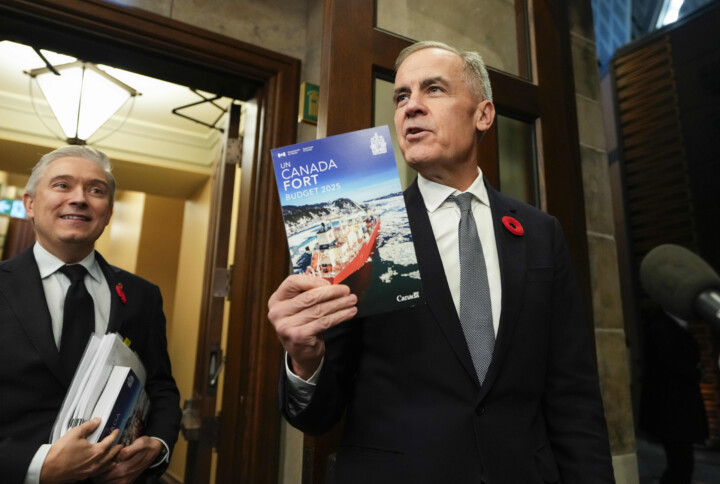The following remarks were delivered in the Senate on October 22, 2024, by Senator Colin Deacon as a response to the Speech from the Throne. In this speech, Senator Deacon makes the case for why Canada holds the potential to become home to the most effective and cost-efficient carbon dioxide removal technologies in the world.
Honourable senators, I rise today with a sense of urgency: The 2021 Speech from the Throne laid out an ambitious vision to build a more resilient economy and a secure, cleaner, and healthier future for our children and grandchildren. The bolder climate action commitment spoke to the very survival of the planet and the prosperity of our country.
Colleagues, when that speech was given in November 2021, the world was grappling with the aftershocks of COVID-19, but the climate crisis was not waiting for the world to catch its breath.
Earlier that year, the town of Lytton, B.C., recorded an unprecedented temperature of 49.6 degrees Celsius, just prior to being literally incinerated. That fall, B.C.’s Lower Mainland was devastated by a now-common phenomenon called an atmospheric river, causing $1 billion in catastrophic flooding and severing access to Vancouver.
Extreme weather events are now commonplace, causing billions of dollars in damage and seemingly endless harm to families, communities, and infrastructure.
As we approach the mid-point of this decade, we must ask ourselves: are we taking bold steps to reduce greenhouse gas emissions while ensuring that our economy remains globally competitive and resilient?
According to Environment and Climate Change Canada, or ECCC, Canada’s economic activity produced 698 megatonnes, or 0.7 gigatonnes, of greenhouse gas emissions in 2021. Despite the promise of bolder climate action, this number remains largely unchanged today.
Additionally, according to a recent article in the journal Nature, Canada’s 2023 forest fire emissions more than doubled our annual emissions. Although not accounted for in the greenhouse gas inventory methodology, it’s still worth noting that Canada’s forest fire emissions alone equalled India’s total emissions in 2023.
Suffice it to say, Canada is not on track to meet our 2030 target of reducing emissions to 45 percent below 2005 levels, nor is the world. At 0.7 gigatonnes, Canada only produces a tiny fraction of the 50-plus gigatonnes of global emissions. That’s often cited as a reason we should wait for others to act. But bold climate action is not just an obligation; it’s an unequalled opportunity to improve Canada’s economic resilience and prosperity. That’s the purpose of my response to the Speech from the Throne today.
But first, let me offer an analogy: imagine you’re locked in a room that is rapidly filling with smoke. You quickly try and block the source of the smoke. This instinct is reflected in our much-needed efforts to reduce our greenhouse gas emissions, but even if you do slow the rate of accumulation, you’ll still be eventually overwhelmed if you don’t clear the air. Similarly, humanity must find a way to rapidly clear the historical CO2 emissions from our atmosphere. This is the role of carbon dioxide removal, or CDR. I’ll be using the CDR acronym a lot today.
Many greenhouse gases, but particularly CO2, linger in our atmosphere for centuries. A study from Norway suggests that CO2’s full impact on our climate may take 50 years to manifest. This means that the emissions from the 1970s, when we were all misbehaving in our youth, may be causing the extreme weather events we’re experiencing today, so even if we could reach net‑zero emissions today rather than in 2050, we may still face decades of increasingly severe climate events. Consequently, we can’t afford to just reduce our CO2 emissions, but we must work to remove CO2 from the atmosphere.

Visitors explore Peggy’s Cove, N.S., Saturday, July 4, 2020. Andrew Vaughan/The Canadian Press.
The good news is that practical CDR methods are available to scale today, and Canada could quickly become a much-needed global leader in scaling these technologies. Carbon dioxide removal, or CDR, methods include harnessing nature to sequester more carbon in our forests and agricultural soils. For decades, Scandinavian countries have proven that agile forestry practices support a highly profitable forestry sector while reducing wildfires, enhancing biodiversity, providing rural and remote jobs, and displacing the use of petroleum products. For example, Sweden’s biomass-fuelled district heating systems provide 75 percent of that country’s heat. Despite 94 percent of Canada’s boreal forests being on Crown land, a lack of effective policy management has turned our forests into carbon sources rather than carbon sinks.
In their report “Critical Ground,” our own Agriculture and Forestry Committee has chronicled the extent to which regenerative agricultural practices can improve our farm productivity by, among other things, sequestering atmospheric carbon and nitrogen in soil. Most other developed nations have effective policies and programs to incentivize and reward these activities, but not Canada.
Other nature-based methods include using proven approaches to enhance the alkalinity of our rivers and oceans. These methods reverse the disastrous effects of acidification while capturing and permanently sequestering CO2 as a dissolved salt in our oceans.
For 20 years, Nova Scotia’s salmon fishers have been carefully introducing lime into the rivers to reverse the effects of acid rain and improve salmon habitat. It turned out that this process also sequestered atmospheric carbon. Nova Scotia-based CarbonRun is now scaling this ecology-restoring CDR method. Recently profiled in the New York Times, CarbonRun was just selected to receive a $25-million advance purchase of carbon removal credits from a group of global technology leaders.
Planetary Technologies, which has partnered with Dalhousie University, Nova Scotia Power, and many others, is a top-20 finalist out of, I think, 1,600 companies globally for the $100‑million Carbon Removal XPRIZE.
Honourable senators, both these Nova Scotia companies are world firsts in their fields, with a strong global export potential of carbon removal credits.
Direct air capture, or DAC, is another rapidly maturing technology. DAC removes CO2 directly from the air and stores it permanently underground. Very small-scale facilities are already operational in Iceland, and Montreal’s Deep Sky is gaining global attention for its focus on identifying and scaling the most promising DAC technologies, both in Quebec and in a new $100‑million facility in Innisfail, Alberta. It’s also worth noting that a B.C. company called Carbon Engineering pioneered the development of DAC technology to remove CO2 from the atmosphere.
Direct air capture technologies offer some of the greatest certainty in terms of permanent carbon removal but are still very expensive. Like every technology, iterative improvements compound over time to transform cost-benefit ratios. Consider that photovoltaic solar cell costs have dropped by over 90 percent since 2009 and lithium-ion batteries are 97 percent cheaper than in 1991.
One last point worth noting is this: CDR technologies differ from point-source carbon capture and storage, which is designed to reduce CO2 emissions from ongoing industrial activity. To go back to our original analogy, carbon capture and storage slows the rate at which smoke is filling the room but does not clear the air. They are point-source, or smokestack, carbon capture methods that help to reduce the rate at which emissions enter the atmosphere, but to be clear, carbon capture and storage is not CDR.
Honourable senators, despite the enormous promise, CDR know-how and technologies are just starting to be integrated into our public policy frameworks. We need to move faster because Canada has the potential to build a globally leading CDR industry that creates opportunity, jobs, and prosperity across our country and into our remote and rural communities.
The product of this emerging industry sector is carbon removal credits that can be sold to businesses and countries that cannot completely reduce their emissions, and these credits will play a crucial role in fighting climate change.

People participate in a climate protest on Parliament Hill in Ottawa on Friday, Sept. 15, 2023. Sean Kilpatrick/The Canadian Press.
To capture the related economic opportunity, Canada must create the regulatory and market frameworks that will attract domestic and foreign carbon removal credit revenue and investment. Both are essential to accelerating the work of CDR innovators. This sort of strong public policy leadership will attract global attention and enable us to rapidly create a new industrial sector of CDR companies that deploy, iterate, and improve their technologies here in Canada.
We already have so many elements working in our favour. Let me list a few: we have the necessary geology, forests, agricultural land, rivers, and oceans, as well as an income tax credit system—thanks to Bill C-59—that can help underwrite the cost of scaling globally leading technologies. The promise of being the first country to develop a direct air carbon capture protocol following on the heels of other leading protocols is also an asset, as are generations of experience as a trusted investment destination. We are host to the world’s leading annual metals and mineral investment conference. Let’s become the carbon market leader.
So how do we finally start to turn this achievable opportunity into a reality? First, our policymakers and politicians must internalize the importance of both reducing emissions and increasing the rate at which we remove past emissions. Simply, we need an all-hands-on-deck attitude if we’re going to find the lowest cost and most effective ways to reduce the concentration of CO2 in our atmosphere.
Second, our regulators must create credible, buyer-centric market frameworks that attract carbon removal credit buyers. These regulators will have to prioritize listening to the needs of buyers of carbon removals and CDR innovators and investors. To succeed, we need regulations that catalyze investment in CDR.
Honourable senators, regardless of the level of Canada’s emission reduction success, we will still have to remove past greenhouse gas emissions. Canada can capture this massive opportunity by sending a strong and consistent demand signal to countless groups that are already starting to invest billions elsewhere.
Success will require political will, leadership and commitment, and a demonstrated capacity to do what it takes to deliver on that commitment, but like anything else important in life, details will matter a lot, so here are some specifics as to where we need to focus if we want to make reliable progress.
First, let’s assemble the talent, capacity, experience, and networks so that Canada’s regulators can deliver certainty and trust to global carbon removal buyers and CDR investors by creating and updating market-centric protocols.
Second, let’s reduce complexity. We need one identifiable group responsible for policy development, program delivery, and regulatory coordination both domestically and globally.
Third, let’s use government procurement power to send a demand signal. Budget 2024’s commitment to include carbon removal in the Low‑carbon Fuel Procurement Program is a really good start, as is Minister Anand’s recently announced commitment to purchase $10 million in carbon removal credits.
Fourth, let’s integrate carbon removal credits into the federal carbon pricing system, helping to create a reliable revenue stream that builds long-term demand for these technologies.
Fifth, let’s adopt a national approach to CDR certification and greenhouse gas accounting that recognizes, builds from, and certifies the best voluntary standards, and integrates those standards into Canada’s compliance carbon market.
And, sixth, let’s integrate Article 6 of the Paris Agreement into Canada’s policy frameworks. Leading organizations such as the International Emissions Trading Association have been encouraging Canada to finalize this framework. This would provide market certainty for carbon removal credit buyers and CDR investors. Formalizing Article 6 will unleash the full potential of globally aligned market frameworks so that the funding flows to the most reliable and cost-efficient technologies.
Lastly, Canada is hosting the 2025 G7 meeting. Let’s make CDR a central theme in an effort to signal the importance of global market alignment and coordination.
Colleagues, as elections unfold across the country, there’s a unique opportunity for new governments to not only build on current efforts to reduce CO2 emissions but also to implement effective strategies to remove CO2 from our atmosphere. Canada must ensure policy consistency through the next decades if we want to achieve the goal of prosperity and decarbonization. Consistent leadership will enable us to become a global magnet for the investment needed to attract and scale CDR know-how and technologies in Canada and for those companies that will remove carbon dioxide from the atmosphere.
Canada can help the world save itself. Thank you, colleagues.
This article was made possible by Deep Sky and the generosity of readers like you. Make a one-time contribution today.










